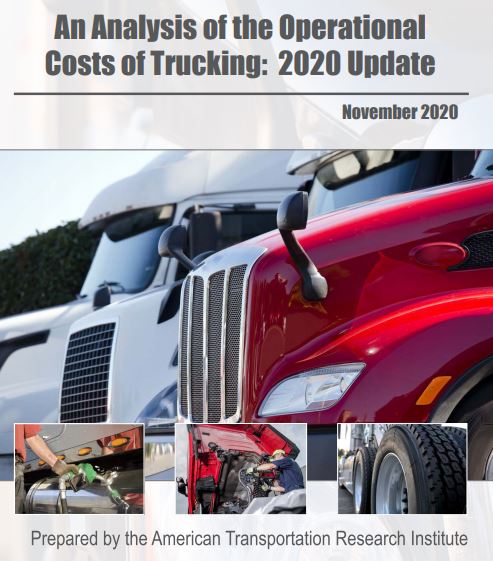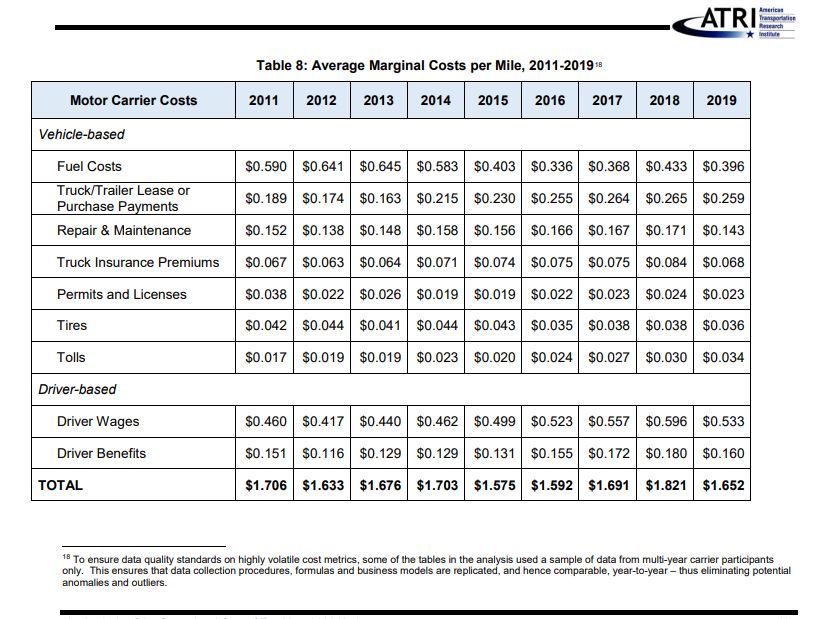Operational costs of trucking fell in 2019
ARLINGTON, Va. – There was a significant decrease in the operational costs of trucking last year, the American Transportation Research Institute (ATRI) said Tuesday.
“The average marginal cost per mile incurred by motor carriers in 2019 decreased 9.3% to US$1.65,” ATRI said in its 2020 update to An Analysis of the Operational Costs of Trucking.

“The line-item costs for almost every major line item experienced some level of decrease. In comparison to the last freight softening, which took place in 2016, marginal costs were still 6 cents higher, indicating the persistence of generally higher costs,” the research organization said.
It said the economic softening, combined with a number of independent factors including lower fuel prices, decreased the marginal cost of trucking.
“Combined driver wage and benefits decreased slightly in 2019 – from 77.6 cents per mile in 2018 to 69.3 cents per mile – a counterintuitive decrease given the driver shortage,” ATRI said.
However, bonuses for drivers universally increased, with retention bonuses showing increases of over 80%.
ATRI said despite the dip in driver wages and benefits in 2019, driver compensation is expected to surge back in 2020 due to Covid-19.
“As more Americans sheltered and worked from home, consumer demand increased for delivered goods and e-commerce,” ATRI said.

The report includes a targeted analysis, which compares fleets of 100 or fewer trucks to fleets with greater than 100 trucks.
“Given the chaos and volatility of freight markets these days, it is more critical than ever that trucking fleets closely monitor their cost centers,” said Brandon Knight, principal of Transportation for CliftonLarsonAllen LLP.
“ATRI’s operational costs report is an important benchmarking tool for fleets of all sizes and sectors.”
In 2019, the U.S. trucking industry hauled 11.84 billion tons of freight, representing 72.5% of the total domestic tonnage, ATRI said.
Looking forward, it said, 2020 data will certainly reflect the most impactful year of social, medical and economic change seen in many generations.
“Until a full year of 2020 data is collected and analyzed, only anecdotal analyses are available. Given the increasing freight demand and the pressures of the driver shortage, it is likely that driver wages in 2020 will increase.”
Have your say
This is a moderated forum. Comments will no longer be published unless they are accompanied by a first and last name and a verifiable email address. (Today's Trucking will not publish or share the email address.) Profane language and content deemed to be libelous, racist, or threatening in nature will not be published under any circumstances.
-
And I have been in the trucking industry since 1971 and I have never seen so much this courtesy in the trucking industry as I am seeing today drivers pull into fuel stops to just go out and get something to eat and don’t even worry about the driver that’s behind them that that driver might be out of fuel these drivers today do not care so these companies get what they pay for a warm body in that truck
Didnt account for all the data programs you need to operate or profit margins
What is the hourly cost? More and more trucking is moving toward shorter haul length and many people are looking at hourly costs. In 2018 my hourly cost was $62.26 which was well below industry average, but went up to over $68 in 2019. I didn’t figure out what my 2020 hourly cost was yet. The increase in 2019 was due to a high percentage of fleet upgrades that ideally would have been spread out over a longer time period.
You know in the trucking industry there’s a lot of drivers out there that should be making a lot more money but with that said there’s a lot of drivers out there that shouldn’t even be making the money that they’re making because they’re driving habits create hazardous driving conditions for other people on the road they go to metropolitan cities at 75 80 mph how in the hell can that be safe and it’s mainly trucking companies coming out of California that I see coming through Albuquerque New Mexico